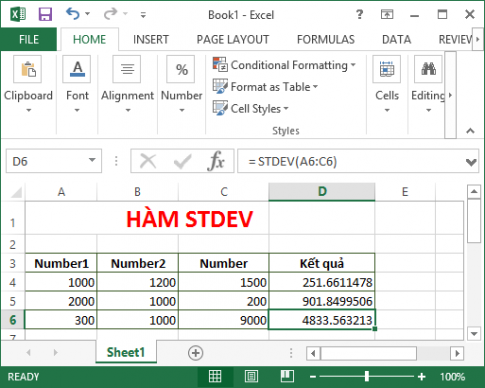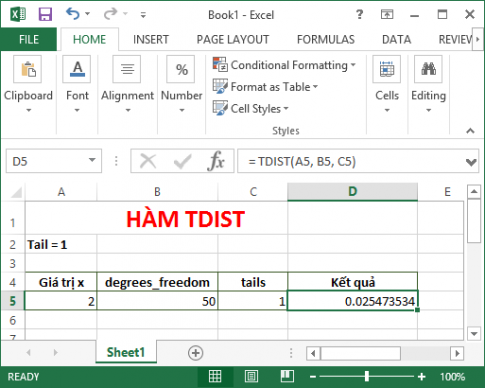

Function to calculate standard deviation, probability and amortization in Excel
- 24-07-2022
- trienkhaiweb
- 0 Comments
With strong support from Microsoft Excel version, we can easily calculate sample standard deviation, amortization and probability using built-in functions. The following article will share more about functions and syntax of functions.
Mục lục
first . STDEV . function
- Function: Helps us to estimate the standard deviation based on the sample. The standard deviation is a measure of the dispersion of the values from the mean.
- Syntax: STDEV(number1, [number2] …)
- Usage :
Number1: The first argument corresponds to the population sample. Required value.
Number2: Arguments from 2 to 255 correspond to the population sample. Optional value is not required
- For example: We have 3 products, each product has a durability corresponding to number1… as shown below. You enter the formula into the cell to be calculated, we get the result as shown below.

- Note:
-STDEV assumes that its arguments are sample populations. If all data can be aggregated, standardize the deviation using STDEVP as in item 2.
-Standard deviation is calculated using the "n-1" method.
-Arguments can be numbers or names, the reference array contains numbers.
Logical values represent numbers as text that you type directly into the list, those arguments become a drawback.
-If the argument is an array or reference, only the numbers in that array or reference will be counted.
-Empty cells, logical values, text, or values in arrays or references may be omitted.
-Arguments that are text or error values that cannot be converted to numbers will cause an error to occur.
-If you want to include logical values and text representations of numbers in the reference as part of a calculation, use STDEVA
2 . STDEVP . function
- Function: Calculates the standard deviation based on the entire population provided as an argument. The standard deviation is a measure of the dispersion of the values from the mean.
- Syntax: STDEVP( number1, [number2]…)
- Using:
Number1: The first numeric argument corresponding to the population. Required value.
Number2: Numeric number from 2 to 255 corresponding to the population.
3 . AMORDEGRC . function
- Function: The Excel Amordegrc function returns the depreciation for each accounting period using the depreciation factor.
- Syntax: AMORDEGRC(cost, date_purchased, first_period, salvage, period, rate, [basis])
- Using:
-cost: cost of the property, required parameter
-date_purchased: asset purchase date, required parameter
-first_period: end date of first period, required parameter
-salvage: salvage value at the end of the asset's life
-period: period
-rate: depreciation rate
-basic: base year is used, optional
– basic = 0 or skip 365 days
– basic = 1 : actual
– basic = 3: 365 days/year
– basic = 4: 360 days/year
Attention:
The AMORDEGRC function returns the depreciation until the end of the asset's life or until the accumulated depreciation is greater than the asset's cost – salvage value.
Depreciation factor:
+ 1.5: Corresponds to the life of the property from 3 to 4 years
+ 2: Corresponds to the life of the asset from 5 to 6 years
+ 2.5: Corresponding to the asset life cycle of 6 years or more
– Depreciation rate increased to 50% in the period before the final period and increased by 100% in the last period
– If the asset's life cycle is from 0 to 1, from 1 to 2, from 2 to 3, from 3 to 4, the AMORDEGRC function returns #NUM!
4 . TDIST . function
Function: The TDIST function in Excel is a function that returns the probability of the Student distribution (t distribution), x is the calculated value of t and is used to calculate the probability. The t-distribution is used in hypothesis testing of small sample data sets. The function is used instead of the table of standard values of the Student distribution.
Syntax : TDIST(x, degrees_freedom, tails)
Using:
– x : Value to calculate Student distribution.
– Degrees_freedom: integer indicating degrees of freedom, required value.
– Tails: determines how the remainder of the distribution is returned.
+ If tails = 1, TDIST() returns the partial distribution
+ If tails = 2, TDIST() returns a two-way distribution. Required value.
Example: Calculate the Student distribution with the value x= 2 and the number of degrees of freedom of 50, in the case of tail =1?

Good luck!!
















